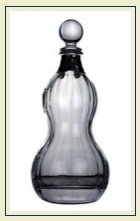The Board affirmed a refusal to register the "product packaging mark" shown below for "mezcal," finding that the proposed mark is not inherently distinctive and fails to function as a trademark under Sections 1, 2, and 45 of the Trademark Act. In re AGPCH, S.A. de C.V., Serial No. 87125518 (April 18, 2018) [not precedential] (Opinion by Judge Cynthia C. Lynch).

Unlike product design, product packaging may be inherently distinctive. In determining whether a particular packaging is inherently distinctive, the Board considers the factors set forth in Seabrook Foods, Inc. v. Bar-Well Foods Ltd., 196 USPQ 289, 291 (CCPA 1977), any one of which factors may be dispositive:
- whether the proposed mark is a "common" basic shape or design.
- whether it [is] unique or unusual in a particular field;
- whether it is "a commonly-adopted and well-known form of ornamentation for a particular class of goods viewed by the public as a dress or ornamentation for the goods" or "a mere refinement" thereof.
The Board first considered the relevant field within which to consider applicant's packaging. Applicant argued that the field should be limited to "mezcal" and should not encompass alcoholic beverages or beverages generally. Examining Attorney Melissa S. Winter contended that the field should be broadened to "the beverage industry as a whole." The Board found the "distilled spirits market" to be the most reasonable category of goods for comparison purposes, sine retailers group distilled spirits together in presenting them to consumers.
Both applicant and the Examining Attorney submitted evidence of other bottle designs:

The Board concluded that applicant's design "cannot be considered unique or unusual in the field, and constitutes a mere refinement of a commonly-adopted and well-known form of ornamentation for liquor bottles." The first bottle above has "an overall design almost identical to Applicant's 'gourd-shaped' bottle ... with a spherical stopper and what Applicant calls a 'capsule' that spreads down over the neck of the bottle."
The next three bottles - for mezcal, vodka, and liqueur - show the prevalence of hourglass-shaped bottles, two of them having a round stopper like applicant's. Other third-party bottles have spherical stoppers and vertical ribs. Many bottles contain neck rings and capsules. The Board found that the differences in applicant's design from these other bottles are "mere minimal refinements of common designs, rather than significant differences from them." Even if applicant is the only current user of its exact combination of features, "this fact alone does not imbue the design with source-identifying significance."
The two prior cases cited by Applicant - involving Procter & Gamble's cat food can and Creative Beauty's perfume bottle - each include evidence that the designs there at issue received awards or other recognition. Here, applicant relies only on "its bare contention that the design it intends to use is unique in the field."
We find that Applicant's bottle design gives its product an attractive appearance, and that consumers would not be predisposed to view this relatively commonplace decorative bottle design as source-indicating. *** Ultimately, we find Applicant's bottle design a commonly-adopted and well-known form in the industry, and the slight differences from third-party bottles merely refine the common design in unremarkable ways or with other common bottle features.
The Board concluded that, under the second and third Seabrook factors, the packaging design at issue is not inherently distinctive. And so the Board affirmed the refusal to register.
The content of this article is intended to provide a general guide to the subject matter. Specialist advice should be sought about your specific circumstances.
